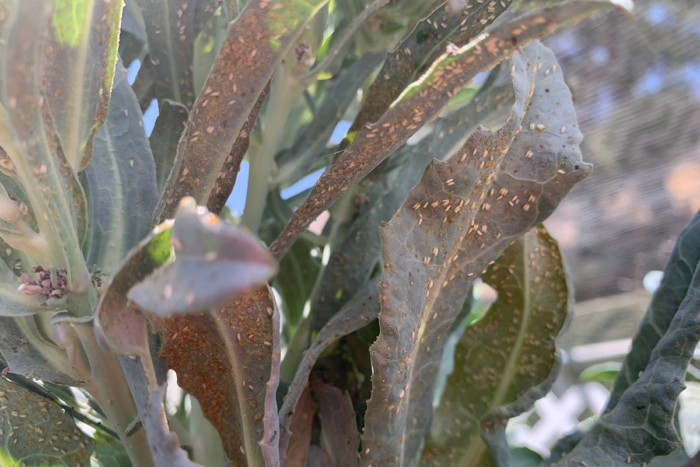
Whiteflies are familiar across the country as greenhouse and indoor-plant pests. But in our warm climate, two species of these unwelcome little sap-sucking insects are very prevalent. Silverleaf whitefly (Bemisia argentifolii) and giant whitefly (Aleurodicus dugesii) are particularly bad in Southern California. While they both infest many different kinds of plants, they are most pesky when they attack the edible garden in droves. Sure, there are harmful pesticides available to control these destructive insects, but the whole point of an edible garden is to have fresh, healthy, tasty, homegrown food. So how do we manage these unwelcome invaders in an organic way and keep them from ruining our edibles?

Understanding and identifying whiteflies
Whiteflies are tiny mothlike insects. When disturbed, they burst into the air in a snowy cloud. Adults and nymphs prefer to hide on the underside of leaves, where they pierce the leaves with their mouth parts and suck out the juices. These insects are masters at prolific reproduction, and the winged adults quickly disperse to create new colonies. They may be small, but they can become so numerous that they can fully coat the underside of a leaf’s surface. You can see eggs, crawlers, nymphs, pupa, and adults all massed together as if sprayed on. Although they rarely kill the host plants, whiteflies cause serious disfiguring and are not at all appetizing on our edible plants. As they feed, whiteflies in development stages secrete a sticky substance that encourages the development of sooty mold, a fungus that blocks light and a plant’s ability to photosynthesize.
Whiteflies are particularly attracted to members of Cucurbitaceae (including melons, squash, and cucumbers), Brassicaceae (like cabbage and mustard), and Solanaceae (tomatoes, peppers, potatoes, and eggplant), as well as some legumes (peas and beans), herbs (especially basil), and more. Citrus trees and some other fruits also fall prey to these pests.
Treatment
Use water. Treating your plants in the safest way will likely require repetitive work, since adults fly off quickly and establish new colonies readily. Regularly washing leaves with a strong stream of water (or water mixed with a mild soap) is the simplest way to fight whiteflies and may be all you need if you get them early. One curious thing about whiteflies is that they seem to return to their favorite host plants time and time again, so removing the heavily impacted plants altogether is helpful.
Spray with organic products. You can use insecticidal soaps, horticultural oils, and sprays such as organic neem oil. These work by way of contact toxins or suffocation, but juvenile whiteflies may be more resistant due to their natural protective coatings. To remove masses of whitefly pests with sprays, you may have to spray on a daily basis at first (following the product labeling instructions), just to knock down the numbers. Apply any of these during the coolest time of the day to minimize stress to your plants.
Get creative. The whiteflies’ search for their feeder plants can be handicapped by using aluminum foil under host plants. This can “foil” their radar by deflecting the insects’ senses. Or try cutting up yellow pieces of cardboard, slathering them with petroleum jelly, and hanging them close to your edible plants. The flies are attracted to the color, then become stuck to the cardboard. You can even suck up flying adults with a hand vacuum to reduce the number of breeding adults. (Remember to NOT empty the vacuum inside the house!)
Encourage predators. Ladybugs, lacewings, and an assortment of other predatory insects help control whiteflies. This is another reason to pass on using chemical insecticides, even on ornamentals. Otherwise, you will be harming the good guys as well as the bad.
Your best protection is to regularly check the leaves of your edibles and take action to eradicate whiteflies as soon as you see them.
—Jane Gates is a landscape designer based in Los Angeles.


















Comments
Log in or create an account to post a comment.
Sign up Log in